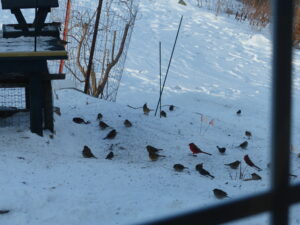Cardinals and other birds visiting wintery backyard feeders need grit. They’ll appreciate finding some near the sunflower seeds and millet.
The old saying that something’s as scarce as a hen’s teeth is as true for the chickadees, cardinals, and goldfinches that visit backyards as it is for the hens in our coop. Birds have no teeth. Before they can digest coarse corn and wild seeds it must be thoroughly chewed. How do they do it?
What Is Grit?
Seeing birds along wintery roads solves the mystery. They’re picking up and swallowing tiny pieces of rock that will descend into their gizzard. A gizzard is a powerful muscular pouch that grinds tough seeds against grit, resulting in a seed slurry that then moves through the bird’s digestive system. Grit is a bird’s teeth.
When Is A Good Time to Spread Grit?

Birds flock to the seeds.
During warm months birds have no trouble finding tiny stones in bare patches of earth, but when the world is blanketed in snow or ice, they can’t find grit. Winter is when they appreciate swallowing a few tiny stones near bird feeders.
What Types of Grit Are Best?
As we fill our feeders at Winding Pathways, we sprinkle grit in with seeds and dribble some on the ground. We use two kinds of grit. When we have it on hand, we prefer baby chick grit that we buy at a farm store. It is tiny pieces of sharp quartzite that’s especially effective in grinding seeds in a gizzard. It’s sized for tiny baby chickens, so it’s just right for backyard feeder birds. When we don’t have it on hand we use regular sand. Traction and kid’s sandbox sand both work well and can be purchased at most home supply stores.
How Much Grit?
- Birds flock to the seeds.
- Sprinkle grit once a week to help birds in the snowy season.
- Spread grit when the ground is snow or ice covered.
Birds must have grit, but they don’t need much. A handful in and around feeders once or twice a week is plenty.
Other Uses
Grit’s useful around the house. When walkways are snow-slicked humans are mostly likely to slip and fall. Tossing grit on slippery walkways creates traction for people and may prevent a painful fall. Birds spot it there and occasionally pick up a few pieces. We keep about 50 pounds on hand and use most of it for traction and just a tiny fraction for our birds.
This winter when filling bird feeders scatter a bit of grit. Cardinals and other birds will appreciate it.



